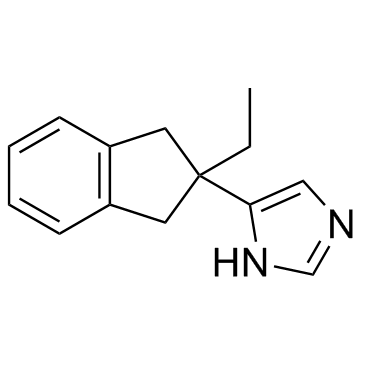104054-27-5
| Name | 5-(2-ethyl-1,3-dihydroinden-2-yl)-1H-imidazole |
|---|---|
| Synonyms |
Atipamezolum [Latin]
MPV-1248 1H-imidazole, 4-(2-ethyl-2,3-dihydro-1H-inden-2-yl)- 1H-Imidazole,4-(2-ethyl-2,3-dihydro-1H-inden-2-yl) Atipamezol [Spanish] 1H-Imidazole, 5-(2-ethyl-2,3-dihydro-1H-inden-2-yl)- 4-(2-Ethyl-2,3-dihydro-1H-inden-2-yl)-1H-imidazole Antisedan UNII-03N9U5JAF6 Atipamezole |
| Description | Atipamezole is a synthetic α2-adrenoceptor antagonist with a Ki of 1.6 nM. |
|---|---|
| Related Catalog | |
| Target |
Ki: 1.6 nM[1] |
| In Vitro | The affinity of atipamezole for α2-adrenoceptors and its α2/α1 selectivity ratio are considerably higher than yohimbine. Atipamezole is not selective for subtypes of α2-adrenoceptors. It has negligible affinity for 5-HT1, 5-HT2 and I2 bindings sites[1]. |
| In Vivo | Atipamezole is well tolerated in rodents. In anesthetized, normotensive rats, the cardiovascular effects of atipamezole (0.01–1 mg/kg, i.v.) are rather modest. Atipamezole is commonly used by veterinarians to awaken animals from sedation or anesthesia. Atipamezole increases sexual activity in rats and monkeys. In animals with sustained nociception, atipamezole increases pain-related responses by blocking the noradrenergic feedback inhibition of pain. Atipamezole at low doses has beneficial effects on alertness, selective attention, planning, learning, and recall in experimental animals, but not necessarily on short-term working memory[1]. |
| References |
| Density | 1.1±0.1 g/cm3 |
|---|---|
| Boiling Point | 367.1±11.0 °C at 760 mmHg |
| Molecular Formula | C14H16N2 |
| Molecular Weight | 212.290 |
| Flash Point | 178.0±5.7 °C |
| Exact Mass | 212.131348 |
| PSA | 28.68000 |
| LogP | 3.75 |
| Vapour Pressure | 0.0±0.8 mmHg at 25°C |
| Index of Refraction | 1.595 |
| Storage condition | room temp |
| Hazard Codes | Xi |
|---|---|
| RIDADR | NONH for all modes of transport |
